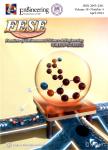Degradation of trace nitrobenzene in water by microwave-enhanced H2O2-based process
Degradation of trace nitrobenzene in water by microwave-enhanced H2O2-based process作者机构:College of Environmental Science and EngineeringGuilin University of TechnologyGuilin 541004China Guangxi Polytechnic of ConstructionNanning 530003China
出 版 物:《Frontiers of Environmental Science & Engineering》 (环境科学与工程前沿(英文))
年 卷 期:2012年第6卷第4期
页 面:477-483页
核心收录:
学科分类:083002[工学-环境工程] 0830[工学-环境科学与工程(可授工学、理学、农学学位)] 082903[工学-林产化学加工工程] 08[工学] 0829[工学-林业工程] 082201[工学-制浆造纸工程] 0822[工学-轻工技术与工程]
基 金:The authors thank the financial support from the Critical Patented Projects in the Control and Management of the National Polluted Water Bodies (No. 2008ZX07317-02-03E) the Key Science Research Projects of Ministry of Education of China and the Provincial Natural Science Foundation of Guangxi (No. Guikegung 0992008-3 Guikeqing 0640070)
主 题:microwave hydrogen peroxide nitrobenzene humic acid
摘 要:To evaluate possible use of microwave- enhanced H2O2-based (MW/H2O2) process to degrade trace nitrobenzene (NB) in water, a series of batch experiments were conducted. The results showed that 2450MHz microwave irradiation significantly enhanced oxidative decomposition of nitrobenzene (NB) in a H2O2 system. About 90% NB was degraded by the MW/H2O2 process in 30 min. Moreover, the MW/H2O2 process could enhanced the oxidative degradation of NB even at relatively low temperature (50℃). When the initial concentration of NB was 300gg/L, the optimum ratio of H2O2 to NB and MW power were 70 and 300W respectively. The presence of humic acid significantly increased H2O2 dosage. The ultraviolet absorbance at 254 nm (UV254) indicated degradation of NB was stepwise and some intermediates were produced. The gas chromatography-mass spectrometric (GC-MS) analysis showed that main intermediates were nitrophenolic and carbonyl compounds.



